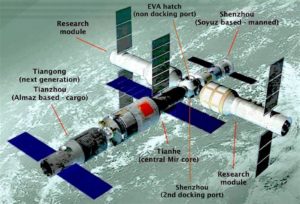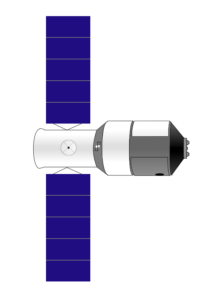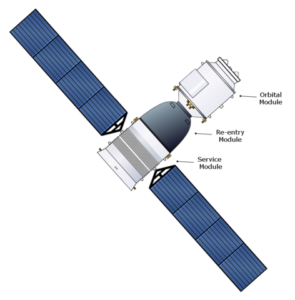A few days ago China launched a crewed mission to it’s newest space station, Tiangong 2. The crew has since successfully docked and are, as far as reports indicate, having a perfectly normal mission on board the orbital laboratory. Obviously in reading this you know that they are space stations, sure, but just what are they in reality? What are the machines, and what is their role? Let’s take a very quick look.

Artists rendering of the Tianhe space station concept.
The Tiangong program was started in 1992, but had it’s first launch in 2011. The Tiangaong program is designed to allow China the opportunity to research long duration space flight on their own, towards their plans of constructing their own modular space station, much in the same vein as Mir or the ISS.
Tiangong 1 was launched on September 29th, 2011. It was visited by 2 crewed missions, Shenzhou 9 and 10. It functioned primarly as a “target vehicle” and held its crews for a period of around 2 weeks each. Tiangong 1 is still in orbit, however, through 2016 rumors and eventual confirmation came out that control had been lost of the station, and that a controlled reentry would not be possible. This is similar to Skylab in 1979, as it had no way to safely come down from orbit. The difference is that Tiangong is much smaller, so there is even less chance of any debris from it reaching populated areas, if breakup even occurs over land.

Tiangong 1 diagram.
Tiangong 2 was launched September 15th, 2016. It is designed to support crews for up to 30 days, and conduct more practical research than Tiangong 1. The first crew, launched on Shenzhou 11, is currently residing on the station and things so far seem fine. There are plans for a resupply craft, Tianzhou, to launch in 2017 and demonstrate fuel resupply capabilities.

Shenzhou spacecraft diagram
There are plans for one more Tiangong station, Tiangong 3, and following that construction should begin on the “Chinese Modular Space Station.” From there, who knows what China’s next plans are: quite possibly manned lunar missions, I would guess.
That’s that: I just wanted to share a quick overview, for those interested. As always, check out the links below.
https://en.wikipedia.org/wiki/Tiangong_program
https://en.wikipedia.org/wiki/Tiangong-1
https://en.wikipedia.org/wiki/Tiangong-2
https://en.wikipedia.org/wiki/Tiangong-3
https://en.wikipedia.org/wiki/Tianzhou_(spacecraft)
https://en.wikipedia.org/wiki/Chinese_large_modular_space_station
https://en.wikipedia.org/wiki/Shenzhou_(spacecraft)
